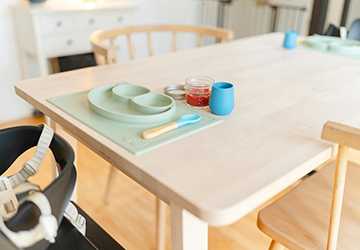Are you sick of spoon-feeding your infant and want a new strategy for solid foods? Baby-led weaning is emerging rapidly as an alternative or replacement for the classic puree feeding process.
Your infant can explore many foods while learning to feed yourself and fine-tune your fine motor skills. Furthermore, the strategy trains a young child to eat well, prevent illnesses, and cultivate an excellent food attitude.
Can you envision the excitement on the baby's face because it can taste and feel the texture of new foods and believes it can feed itself independently? Baby-led weaning, or BLW, is a gratifying and exciting experience for both parents and children.
Read on to learn about the four most critical characteristics of baby-led weaning and determine if it is appropriate for you. Finally, with the insights you collect at the end of this blog post, you can decide if this approach suits your child.

4 Amazing Features of Baby-Led Weaning
Are you ready to explore the incredible benefits of baby-led weaning? Let's now discuss four unique features that make this approach appealing to parents and beneficial for babies.
1.Development of Motor Skills
Subsequently, it was praised for sparking infant motor development. Babies were not fed with a spoon; they could force and press food with their fingers.
The method aids in the development of excellent hand-eye coordination and the capacity for fiddling with the fingers.
In this scenario, the kids seized food of various textures and sizes, learned to coordinate their movements, and tried to adapt to the strength of the clamping and graded force.
2.Encourages Self-Regulation
Eating pace and quantity determine another principle of baby-led weaning, allowing babies their own feeding pace.
Traditional feeding involves a parent controlling the spoon. Baby-led weaning enables a child to choose when to stop and start feeding. The baby will self-regulate feeding by observing hunger and satisfaction cues and listening to its body's needs and cravings.
Eventually, babies develop a natural feeding pattern that allows them to eat once they have an appetite, and such a habit discourages overfeeding.
3.Enhances Food Exploration and Acceptance
Another advantage of BLW is that it exposes babies to diverse flavours, textures, and smells at the onset. For instance, parents can feed babies whole foods naturally, such as proteins, grains, vegetables, and fruits.
The experience offers variations in the breadth and depth of dissertations. A balanced diet promotes curious and adventurous eating, ensuring that infants follow the same path.
According to research, infants undergoing baby-led weaning are likely to accept various foods and adopt a culture of consuming healthy, nutritious foods.

4.Fosters Family Mealtime Bonding
It reinforces oral involvement and involvement in mealtimes away from family. There is no specific baby feeding session; instead, the baby is placed at the table with the rest of the family.
They learn to participate in socializing aspects of the event and watch brother and sister feed by modelling the sibling unfamiliarity for ingesting and imitation.
The experience encourages relationship, interaction, and socialization, allowing the infant to maintain the potential to value and have a place within the congenital organization.
In addition, the family meal event encourages learning and observation from the infant during the eating process.
Embrace the Wonder of Baby-Led Weaning: Take the First Step Today!
Now that you have explored the beautiful benefits of baby-led weaning, you may wonder if it is best for your baby and family. Remember that your baby is unique and that what works for one baby may not work for another.
So, what are you waiting for? Join the delicious and spectacular world of baby-led weaning and see your baby grow in this incredible, fun-filled, and mouthwatering journey.








